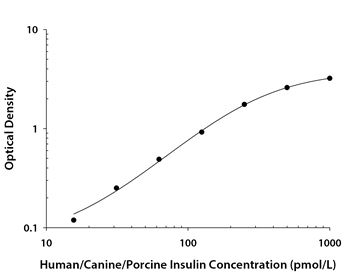Testing Principle This kit uses quantitative sandwich enzyme immunoassay technique. A specific anti- Human / Porcine Insulin antibody is pre-coated on a high affinity plate. Standards, test samples, and biotinylated detection antibodies are added to the wells of the enzyme-labeled plate. After incubation, the Human / Porcine Insulin present in the samples combines with the solid-phase antibodies and the detection antibodies to form immune complexes. After washing to remove unbound material, horseradish peroxidase-labeled streptavidin (HRP) was added. After washing, a chromogenic substrate was added, and the color was developed in the dark. The reaction was stopped by adding a stop solution, and the absorbance was measured at a wavelength of 450 nm (reference correction wavelength of 540 nm or 570 nm). Detection type: sandwich enzyme immunoassay Form: pre-coated 96-well plate Sample type: Cell culture supernatant, Serum, Plasma Sample quantity: 100ul Kit composition: 96 well polysyrene microplate coated with capture antibody, standard, detection antibody, 10×reagent diluent, Color reagent (A and B), 25×wash buffer, Stop solution, ELISA plate sealers, specification Sensitivity: 2.15 pmol / mL Detection range: 15.6 - 1000 pmol/mL Recovery rate: 85.0-108.9% Storage: 2-8 ° C The standard curve: 
Background: Insulin Insulin and IGF are members of the insulin molecule family. IGF-I and II are structurally homologous to proinsulin and can be thought of as an exaggerated inverted G shape. The G part of the chain is inchain disulfide bonded. Single-stranded proinsulin peptide is composed of 30 amino acid residues of B chain (aa 2554), C peptide (aa 5589) and 21 amino acid residues of A chain (aa 90110).The removal of C peptide by proteolysis results in the formation of mature insulin, which is the heterodimers formed by disulfide bonds between A and B chains. Circulating C peptide levels are elevated in hyperinsulinemia, obesity and type 2 diabetes. Technical hints: For research use only, not for in vitro diagnosis. | 




